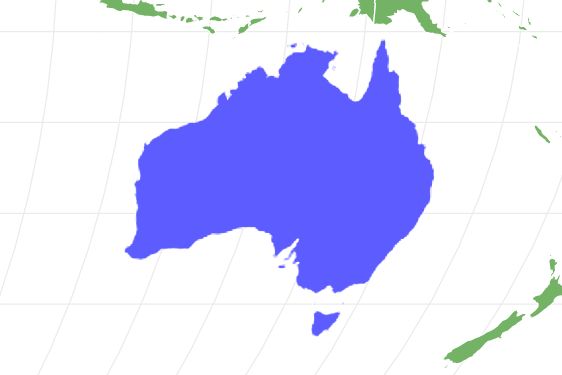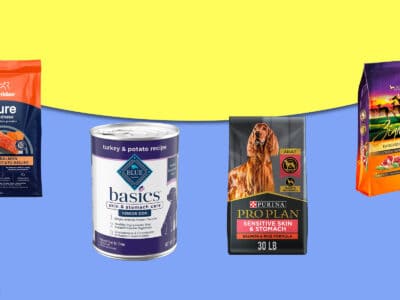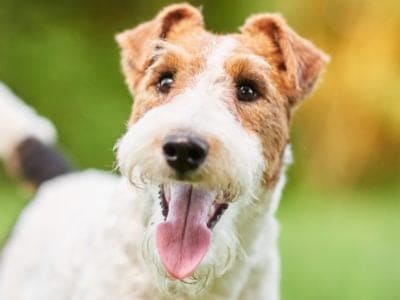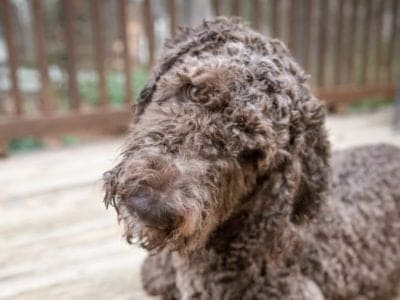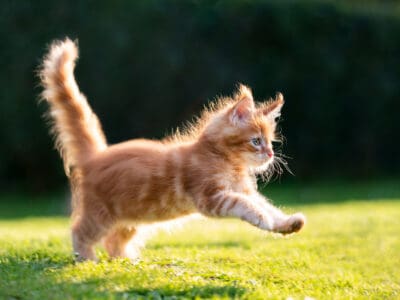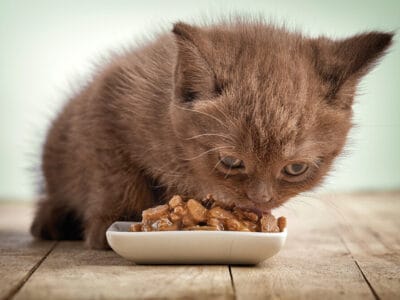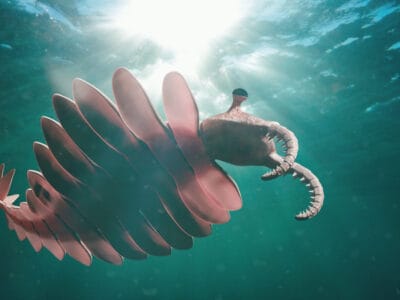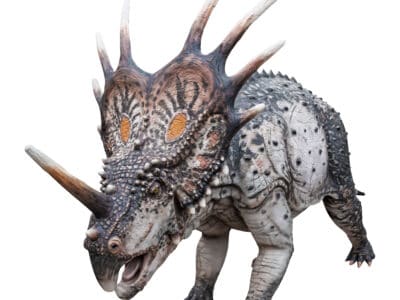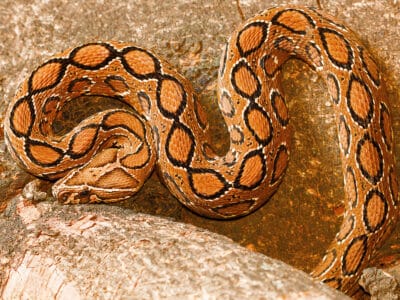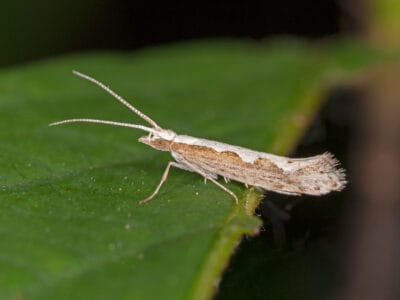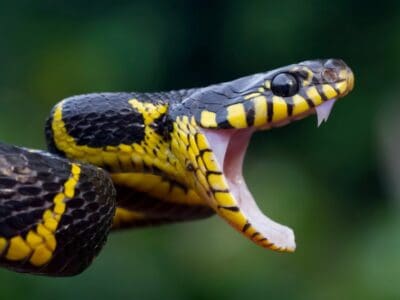Australian Labradoodle
.jumbotron {
background-image: url(“https://a-z-animals.com/media/2021/03/Australian-Labradoodle-header-400×300.jpg”);
}
}
@media only screen and (min-width: 641px) and (max-width: 920px) {
.jumbotron {
background-image: url(“https://a-z-animals.com/media/2021/03/Australian-Labradoodle-header-470×370.jpg”);
}
}
@media only screen and (min-width: 921px) {
.jumbotron {
background-image: url(“https://a-z-animals.com/media/2021/03/Australian-Labradoodle-header.jpg”);
}
}
Australian Labradoodle
Canis lupus
The “Australian” just refers to where the breed originated
Australian Labradoodle Scientific Classification
- Kingdom
- Animalia
- Phylum
- Chordata
- Class
- Mammalia
- Order
- Carnivora
- Family
- Canidae
- Genus
- Canis
- Scientific Name
- Canis lupus
Read our Complete Guide to Classification of Animals.
Australian Labradoodle Conservation Status
Australian Labradoodle Facts
.checked {
color: yellow;
}
Australian Labradoodle as a Pet:
- General Health
- Energy Level
- Shedability
- Trainability
- Intelligence
- Tendency to Chew
- Size
- Family and kid friendliness
- Yappiness / Barking
- Moderate
- Hypoallergenic
- Yes
- Separation Anxiety
- High
- Preferred Temperature
- Average climate
- Exercise Needs
- Moderate
- Friendly With Other Dogs
- Moderate
- Pure bred cost to own
- $2,000-3,000
- Dog group
- Working
- Male weight
- 20-65 lbs
- Female weight
- 15-60 lbs
This post may contain affiliate links to our partners like Chewy, Amazon, and others. Purchasing through these helps us further the A-Z Animals mission to educate about the world’s species..

Spiders that fly! Fish that walk! And 1000+ more incredible animals. Discover them all for FREE
.photo-gallery {
–margin: 0px auto 0px;
–padding: 0px 0px 0px 0px;
}
.gallery-link {
background-image: url(“https://a-z-animals.com/media/2021/03/Australian-Labradoodle-brown-1024×535.jpg”);
background-repeat: no-repeat;
background-size: cover;
background-position: center;
height: 500px;
justify-content: center;
text-align: center;
align-items: center;
display: flex;
border: 2px solid #000;
}
.gallery-link img {
height: 50%;
}
@media only screen and (max-width: 768px) {
.gallery-link {
height: 300px !important;
}
}
View all of the Australian Labradoodle images!
The Australian Labradoodle was bred to be the world’s first hypoallergenic guide dog by the Australian Guide Dog Services, specifically for families who are both visually impaired and allergic to dogs.
The Australian Labradoodle is a designer dog breed from Australia that is a variation on the usual Labradoodle hybrid cross between a Labrador Retriever and a Standard, Mini, or Toy Poodle. It has 6 different parent breeds: Labrador, Poodle, English Cocker Spaniel, American Cocker Spaniel, Curly Coated Retriever, and Irish Water Spaniel. Since appearing in 1988, it has 3 possible sizes: Mini, Medium, and Standard. The clever and loyal breed makes a great working dog for service work. It’s also a great first-time owner or family pet that enjoys children and other pets.
See all of our expert product reviews.
The 3 different types of Australian Labradoodles and Australian Labradoodle mixes
There are three different types of Australian Labradoodles depending on size: Mini, Medium and Standard. Some breeders have petite/micro, small or small-medium sizes.
button.pulse {
transform: scale(1); animation: pulse 2s infinite;
box-shadow: 0 0 0 0 rgba(11, 247, 25, 1);
}
@keyframes pulse {
0% { transform: scale(0.90); box-shadow: 0 0 0 0 rgba(11, 247, 25, 0.5); }
60% { transform: scale(1); box-shadow: 0 0 0 15px rgba(11, 247, 25, 0); }
100% { transform: scale(0.90); box-shadow: 0 0 0 0 rgba(11, 247, 25, 0); }
}
F1 means a first cross, first generation of a purebred standard, mini or toy Poodle to a purebred Labrador Retriever, creating the Labradoodle mix. F1B is F1 with the “B” referring to the backcross of an F1 Labradoodle to a purebred standard, mini, or toy Poodle. Australian Labradoodle contains the DNA of the Labrador, Poodle, and American or English Cocker Spaniel. Finally, the multigen Australian Labradoodle is also known as an authentic Australian Labradoodle, with multigen meaning multigenerational. It is the result of at least 4 consecutive matings between two Australian Labradoodles and years of selection to enrich the dog’s blood with the infusions of the Irish Water Spaniel, English and/or American Cocker Spaniel, and the Curly Coated Retriever. For this reason, F5 generation is typical.
There are many possible Australian Labradoodle mixes. However, an officially recognized one is the Australian Cobberdog. The difference is the crossing with an Irish Soft-Coated Wheaten Terrier. Other mixes are crossings of Labradoodles with other breeds, such as Double Doodle, which is a Labradoodle (Labrador Retriever/Poodle mix) with a Goldendoodle (Golden Retriever/Poodle mix). “Double doodle” also refers to the crossing of 2 different doodle breeds, such as Goldendoodle Labradoodle (aka Golden Labradoodle), Double Labradoodle (Labradoodle with another doodle), Aussiedoodle Goldendoodle (Australian Shepherd/Poodle mix with Golden Retriever/Poodle mix) and Australian Double Doodle (Aussiedoodle with Goldendoodle and at least one other doodles) and Golden Mountain Doodle (Bernese Goldendoodle mix).
3 pros and cons of owning Australian Labradoodles
Owning an Australian Labradoodle: 3 pros and cons
| Pros! | Cons! |
|---|---|
| Little to no shedding: Because of the infusion with Poodles and other low-shedding breeds, it became hypoallergenic. It is ideal for people who are usually allergic to dogs. | Frequent grooming: It needs frequent grooming to maintain its coat and prevent knotting and matting. This means it will need more haircuts than you do. |
| Well-balanced temperament: Labradoodles combine the gentleness and steadfastness of the Labrador Retriever with the instinctual intelligence of the Poodle, resulting in a loyal and easily trainable dog. This designer dog became its own breed after mixing Labradoodles with other breeds to create a dog that has the best qualities of all of them. | May fight with other dogs: it is likely to fight with other dogs of the same sex. This is especially true if the dog is not spayed or neutered and has not been properly socialized. |
| Sociable personality: It loves everyone and while energetic and playful, it’s also even-tempered around children and babies. It gets along with other pets, even other dogs. | It’s high-energy: If you live in a small space, this dog will need more frequent walks than usual. It must have toys and companions to prevent unwanted behavior, such as chewing or barking for attention. If you cannot provide for its energy demands, consider another breed. |
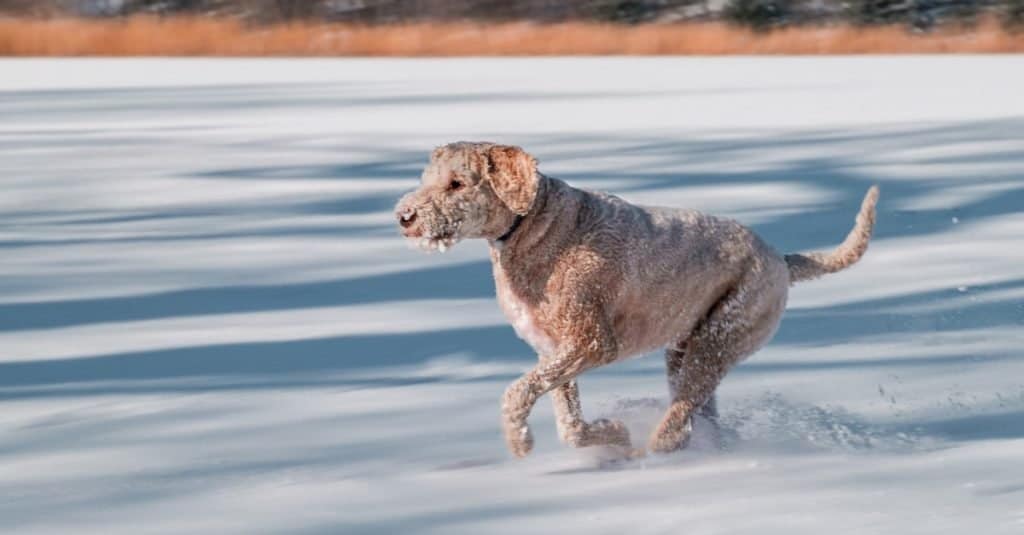
Josiah Gaulke/Shutterstock.com
Australian Labradoodle Size and Weight
The Australian Labradoodle has 3 possible weight and height ranges depending on either size of Mini, Medium, and Standard. The average height and weight for the Mini size is 14-16″ and 15-25lbs, Medium is 17-20″ and 30-40lbs, and Standard is 21-24″ and 45-65lbs respectively, with males being taller and heavier than females. Australian Labradoodle puppies weigh between 3.75-16.25lbs at 7 weeks of age and are typically fully grown between 11-18 months for all sizes.
Health and Entertainment for your Australian Labradoodle
See all of our expert product reviews.
| Height (Male) | 15-24″ |
| Height (Female) | 14-23″ |
| Weight (Male) | 20-65lbs, fully grown |
| Weight (Female) | 15-60lbs, fully grown |
Australian Labradoodle Common Health Issues
Australian Labradoodles are generally healthy dogs. Although it can inherit health issues from its parent breeds, its crossbreeding results in a hardier dog. Patellar luxation, hip and elbow dysplasia, Von Willebrand’s disease, and progressive retinal atrophy are known health issues for its Labradoodle parents. Addison’s disease and progressive retinal atrophy are occasional occurrences with the Australian Labradoodle in particular, especially if its parents have not been PRA before breeding. In sum, the most common health issues are:
- Addison’s disease
- Progressive retinal atrophy
- Hip dysplasia
- Elbow dysplasia
Australian Labradoodle Temperament
The temperament and behavior of the Australian Labradoodle can vary especially in first-generation Labradoodle puppies. However, the higher breeding standards of authentic Australian Labradoodles from reputable breeders results in much more consistent personality traits, although it also means a higher price.
The personality of Labradoodles is gentle, steadfast, intelligent, instinctual, loyal, and easily trainable. These traits were combined with those of other breeds to create the Australian Labradoodle’s unique balance of cleverness, loyalty, gentleness, sociability, affection, and energy, with F5 generations having very consistent behavior.
How To Take Care of Australian Labradoodles
New dog owners looking to care for Australian Labradoodles, especially Australian Labradoodle puppies, must consider its generation and parent breeds. Whether it’s common Labradoodle or Australian Labradoodle issues, or different care related to their coat and size, Australian Labradoodles have many unique factors that must be considered.
The Best Dog Food for Australian Labradoodles
Australian Labradoodles have different health considerations due to their being a designer dog breed, and they are similar to those of Labradoodles. Therefore new owners should consider these factors when choosing a food for their pet:
Australian Labradoodle puppy food: Your choice of puppy food will greatly impact your dog’s ability to properly develop and have good health. Carbohydrates, animal fats, proteins, minerals, vitamins, and amino acids are crucial nutrients along with water, and in the right amounts for the breed and size. A commercial dry or canned puppy food is easiest for guaranteed complete nutrition with animal protein as the primary ingredient. If you feed canned food, decrease it from what you would normally feed with dry food to prevent weight issues.
Australian Labradoodle adult dog food: Commercial dog food, cooked home-prepared food, and a raw diet are all possible options. Both the cooked home-prepared and raw diets should contain meat, bones, eggs, and vegetables.
A-Z Animals says the best dog food for Australian Labradoodles is Stella & Chewy’s Wild Red Classic Kibble Dry Dog Food.
81% of the quality protein comes from animal sources. The real chicken, duck, and turkey make for a nutrient-dense meal. Since Australian Labradoodles can get hip and elbow dysplasia, the glucosamine and chondroitin in this food are vital. Plus, the taurine helps maintain clear eyes and vision.
Here’s where to find Chewy’s Wild Red Classic Kibble on amazon.
- Help Your Pet Thrive: Our Wild Red Classic dog food offers the protein-rich taste dogs crave with the nutrition they deserve
- Feed Your Dog’s Wild Side! Our Classic Prairie Recipe includes three animal protein sources: cage-free chicken, duck and turkey
- Whole Prey Ingredients: Give your pet a diet similar to what their ancestors enjoyed in the wild; 81% of the recipe’s protein comes from animal muscle meat, cartilage and organ meat such as chicken liver
- Wholesome Grains: With nutritious grains such as barley and millet, our recipe is designed to be easily digestible for all life stages, with no unnecessary fillers and only the finest ingredients
- Supports Whole Body Health: Fortified with vitamins, minerals and amino acids, our Classic kibble formula helps improve your dog’s entire well-being, with natural fiber sources such as oatmeal to support healthy digestion and taurine to support heart health
Australian Labradoodle Maintenance And Grooming
Australian Labradoodles have little to no shedding. However, due to its having a straight or wavy fleece coat, this also means frequent knotting and matting without regular grooming. To maintain its floppy, teddy bear-like appearance, and avoid felting its coat, there are some important tips to practice. If the coat is filthy, you must hose it down and put the dog into its crate to allow the dirt to dry and drop off. Average brushing for an adult is 60 minutes every 2 weeks, with more frequent grooming for dogs that play outside in water or come along to hike in nature areas.
For puppies, trimming around eyes and feet is recommended before taking them to the groomer. An inverted V-shape at a diagonal with thinning scissors will give a soft, less choppy look than blunt-tip scissors, while trimming around the feet in a large circle will preserve the floppy look while removing excess hair. Bangs will grow down and naturally part to the side, but you can thin the very center bangs if you so desire. Puppies start to transition to their adult coats 6-8 months with the process lasting 3-5 months. Before then, you must brush your puppy multiple times a week and a professional trim should keep its coat at 1.5-2″ long.
Australian Labradoodle Training
These dogs are intelligent, intuitive, and mature. They are easier to train than other dog breeds. When compared to Labradoodles, they are calmer and more well-balanced. However, they can also be prone to separation anxiety which can continue even after puppyhood and after the family returns home. For this reason, it is best to have toys and other pets for them to play with, especially other dogs.
Australian Labradoodle Exercise
Regardless of the size of your dog, it needs sufficient space and fulfillment of exercise needs. Although you can compensate for medium and standard size dogs in a small living space with more frequent walks, it is recommended to consider a mini size, sometimes alternately called petite/micro, small or small-medium. Adult dogs need 30-60 minutes of exercise every day, including a walk and free play. Long walks or jogs, dog park sessions, and mental stimulation are all important for variety. Puppies are more energetic and demanding attention, and it is during puppyhood that training and socialization begin.
Australian Labradoodle Puppies
The puppies need brushing several times a week. From the time you bring your puppy home to about 6 months of age, it is recommended to feed them 3 times a day. After that, you can feed them twice a day.
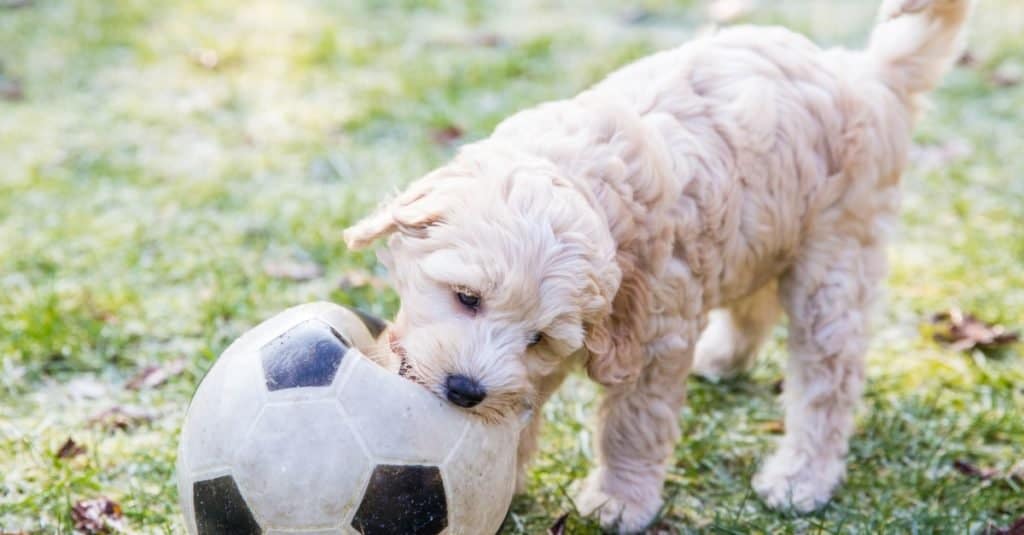
Angeline Dobber/Shutterstock.com
Australian Labradoodles And Children
These dogs love everyone, including children, and everyone tends to love them back. Their easygoing personality becomes even more docile and sociable around children and babies. They make for joyful playmates with them and are also great for first-time dog owners and children learning how to train dogs because they are eager to please and pick up new tasks quickly.
Dogs similar to Australian Labradoodles
Other dog breeds similar to the Australian Labradoodle are the Labradoodle, Bernedoodle and Aussiedoodle.
- Aussiedoodle: A popular designer dog, this is an Australian Shepherd/Poodle mix.
- Goldendoodle: Another popular designer dog, this is a Golden Retriever/Poodle mix. Check out how these two breeds differ here.
- Australian Cobberdog: A rarer hybrid of an Australian Labradoodle crossed with the Irish Soft-Coated Wheaten Terrier, resulting in a different temperament.
Popular Names for Australian Labradoodles
Popular names for these dogs include:
- Biscuit
- Sugar
- Lady
- Bandit
- Bear
- Digger
- Aussie
Last update on 2022-07-06 / Affiliate links / Images from Amazon Product Advertising API
View all 127 animals that start with A
Australian Labradoodle FAQs (Frequently Asked Questions)
What is an Australian Labradoodle?
An Australian Labradoodle is a particular multigenerational designer dog breed that originated in Australia, resulting from the cross between a Labradoodle with several other breeds.
Is there a difference between a Labradoodle and an Australian Labradoodle?
Whereas a Labradoodle is a Labrador Retriever/Poodle mix, the Australian Labradoodle also includes American or English Cocker Spaniel, Irish Water Spaniel, and Curly-Coated Retriever.
Do Australian Labradoodles bark a lot?
They bark mostly to alert their owners of strange noises or presences. Otherwise, if they are bored, they tend to bark for attention.
How do you groom an Australian Labradoodle?
Grooming with a dog brush, trimming of claws with dog nail clippers, and trimming of the coat with thinning scissors are best.
How much does an Australian Labradoodle cost?
The price of Australian Labradoodles depends on whether you buy the dog from breeders or a rescue. Breeders’ prices are more expensive due to health screening and breeding standards. From breeders, you can expect to pay anywhere between $2,000-3,000 for newborn puppies and $350 or more for 10 week-old puppies.
Are Australian Labradoodles good with kids?
Yes, they are great with children and are considered the perfect family pet.
How long do Australian Labradoodles live?
13-16 years.
What are the key differences between Australian Labradoodles and Labradoodles?
The key differences between Australian Labradoodles and Labradoodles are appearance, characteristics, and health factors.
Sources
- Wikipedia, Available here: https://en.wikipedia.org/wiki/Labradoodle
- Juniper Ridge Australian Labradoodles, Available here: https://www.juniperridgeaustralianlabradoodles.com/grooming
- Labradoodle, Available here: https://www.labradoodle.com.pl/australian-labradoodle/your-australian-labradoodle/diet/
- Petguide, Available here: https://www.petguide.com/breeds/dog/australian-labradoodle/
- Good Day Doodled, Available here: http://gooddaydoodles.com/about-the-labradoodle/sizes/
- Green Garage Blog, Available here: https://greengarageblog.org/15-pros-and-cons-of-owning-a-labradoodle
- Labradoodle Mix, Available here: https://labradoodlemix.com/australian-labradoodles-vs-labradoodles/
- All Things Dogs, Available here: https://www.allthingsdogs.com/australian-labradoodle/
- We Love Doodles, Available here: https://welovedoodles.com/double-doodle/
- The Happy Puppy Site, Available here: https://thehappypuppysite.com/double-doodle/
- Labradoodles of the North, Available here: https://www.labradoodlesofthenorth.com/australian-labradoodle-parent-breeds/
- Australian Labradoodle Association Europe, Available here: https://alaeu.com/en/australian-labradoodle-or-cobberdog/
- Australian Labradoodle, Available here: http://australian-labradoodle.org.uk/history/
- Legendary Labradoodles, Available here: https://www.legendarylabradoodles.com/types-colors-labradoodles.html
- We Love Doodles, Available here: https://welovedoodles.com/australian-labradoodle-guide/

